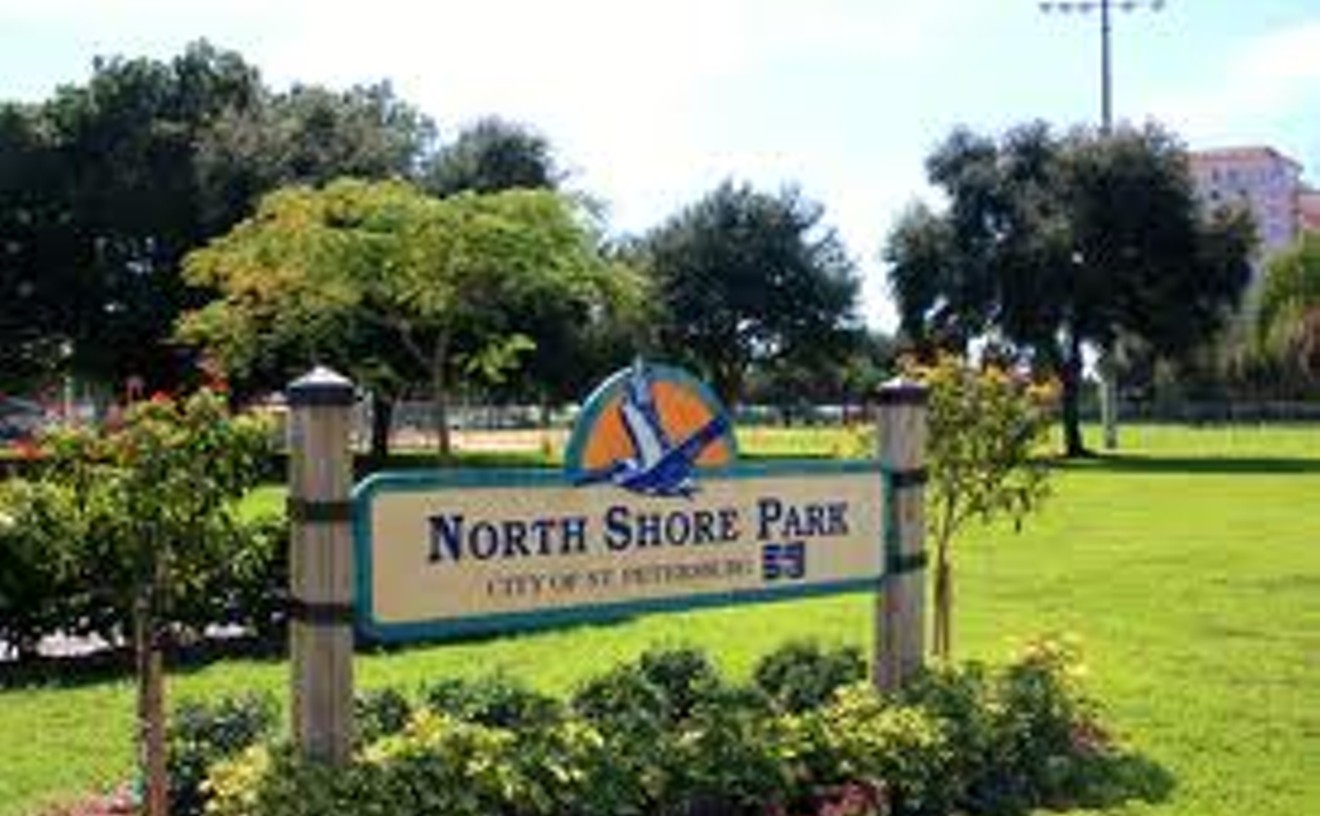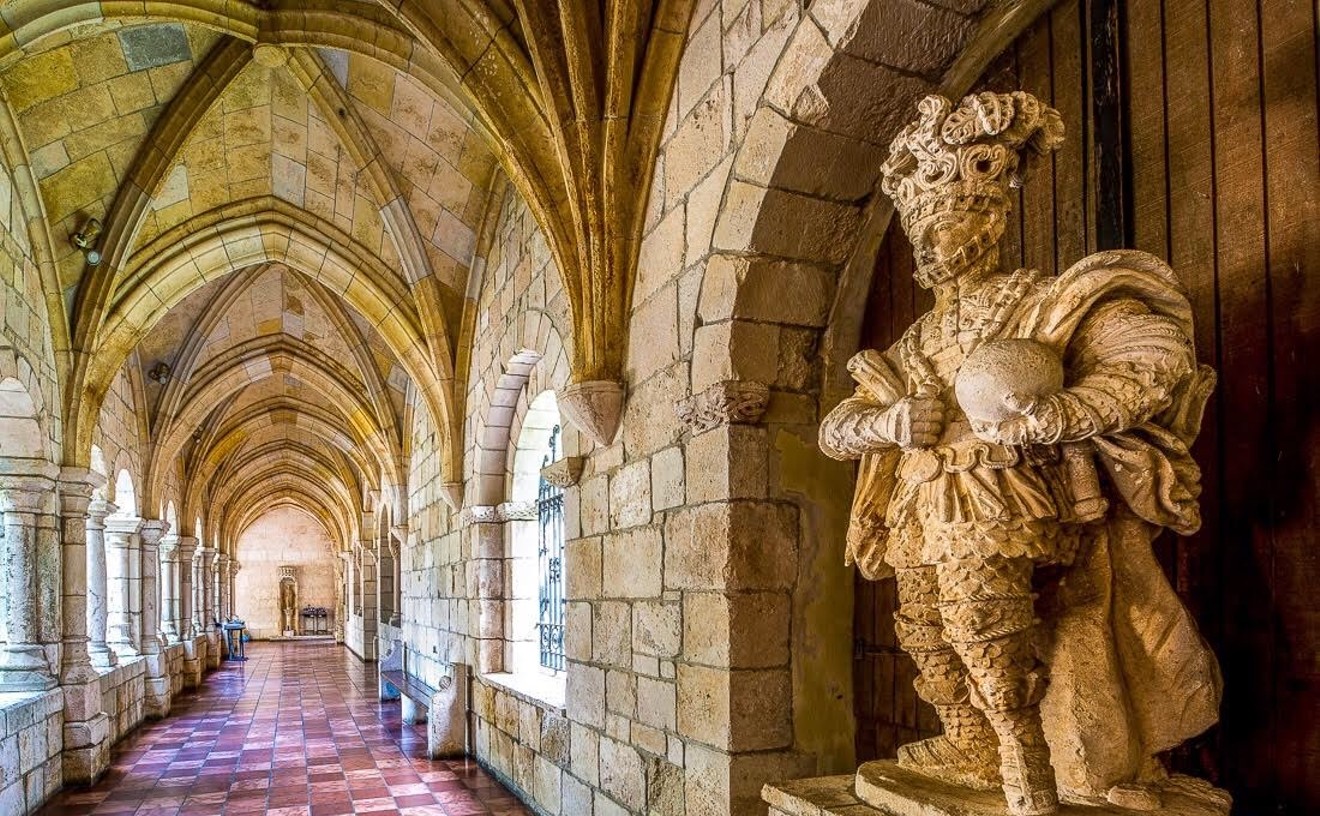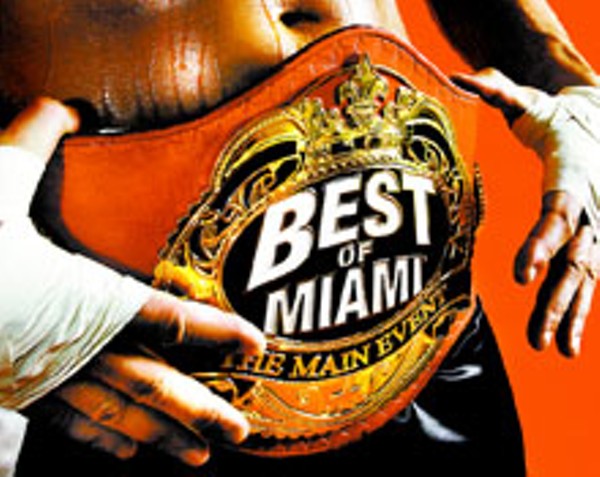Best Party Crasher
Thomas Barker
It's not about wearing fine couture or driving up to the valet in a Bentley; "It's all about the attitude," says Thomas Barker, the little guy behind MUSE Entertainment and columnist for Wire magazine. The adorable brown-haired pixie, who always looks fabulous in his simple white Hanes V-neck T-shirts and two-dollar thrift-store threads, can be spotted everywhere: hotel and condo parties, art gallery openings, and boutique soirees from Lincoln Road to Bal Harbour -- even if he is not on the list. "You don't need to conform to the South Beach style; you just need one great accessory as a conversation starter. This cost more than my whole outfit," Barker says of his gorgeous Murano glass bead rosary. Barker, whose other signature accessory is a martini glass, suggests making friends with a few PR people to get the party ball rolling. Once you work your way into a few fabbity-fab events, you will begin receiving invites to others. "Every party needs to have the right mix of people. You have the intellectual, the beautiful, the fabulous, and the spenders ... and there's always the gays!" Barker laughs. "The key is to look the part and to act like you belong there -- because you do!"
Best Tennis Courts
North Shore Park

Perhaps it's simply a coincidence that the courts at this brand-spanking-new recreation center a few blocks away from Francophile Normandy Isle are clay, the surface of choice for the French Open. Whatever the reason, it's rare to find clay, usually a favorite among elite players, on public courts. So common lobbers, rejoice; with twelve courts (ten clay, two hard surface), fees that cost only a little more than a couple of Gatorades, and nighttime lighting (it's open until 9:00 p.m. weekdays, 8:00 p.m. weekends), there are plenty of excuses to break out some fresh balls.
- 501 72nd St., Miami Beach, 33141 Map
Best Party of the Year
TARA, Ink/T-Mobile Launch
Planning the perfect party takes a little bit of practical chemistry: Bring together a mix of people from enough different social subsets to make for interesting, convivial conversation. But make sure they are not from worlds so alien that guests have nothing at all to say. Serve enough food to sate the starving without stultifying the gluttonous. Lubricate with enough alcohol to loosen inhibitions without encouraging regrettable hookups or, worse, drunken brawls. Find a sponsor generous enough to underwrite the festivities who doesn't subsequently become a demanding boor. And then there's the intangible type of chemistry that just clicks into place, turning an enjoyable but predictable shindig (something that happens almost every night of the year in Miami Beach) into one for the record books. Such an alignment of the stars occurred November 15, 2005, when the celebrity publicists (and publicists to celebrities) of TARA, Ink gave a coming-out party for Douglas Rodriguez's new incarnation of famed Caribbean fusion restaurant OLA at the Savoy on Ocean Drive -- it is located, by the way, in the former home of Rolling Stone Ron Wood's nightclub. The event was on the tab of cell phone and Sidekick service providers T-Mobile, which was simultaneously launching new incarnations of the personal communication devices. It turned out the electronics moguls were the consummate sponsors, rocking the party with witty chat and mingling easily. "I love Miami Beach," commented T-Mobile executive Mark Stockdale. "It's different -- way different than Seattle, where I'm from, but that's the idea." OLA was populated that evening not only by tech-talkin' geeks but also by local scenesters on their best behavior: Kimona, the National Hotel's iconic lounge singer; designer Esteban Cortazar; club owner Nicola Siervo; and Tara Solomon herself, possibly the most gracious hostess ever to simultaneously take a phone call, balance a martini, and personally escort a guest to the restroom in four-inch heels. Yet there were enough civilians -- starving artists and writers, people's parents and grandparents, and even a few children -- to make milling mandatory and introductions painless. The drinks were paired with Rodriguez's magnificent ceviche snacks, crab puffs, spring rolls, and lobster tarts, which led to a full-fledged four-course meal. Guests left full, happy, and madly craving a Hello Kitty-theme Sidekick of their very own. That's the key to party perfection: Satisfy every desire, yet make guests want more. Definitely one for the record books.
Best Public Pool
Coral Gables Venetian Pool

Photo courtesy of the GMCVB
There are certain memories commonly associated with public pools -- such as screaming children, eyes bloodshot from excessive chlorine -- that can, at times, be unpleasant. If you're seeking a special public-pool experience renewal, we suggest a few hours in the sybaritic, neoclassical grandeur and chlorine-free natural spring water of Venetian Pool. Believed to be the only public pool in the country on the National Registry of Historic Places, this 85-year-old, 800,000-gallon pool is one of the Miami area's true wonders. With vine-covered loggias, a three-story observation tower, coral rock caves, and a palm-fringed island, the pool is part Renaissance Italy, part Fantasy Island. At one point, gondolas actually plied the length of the pool. One of its unique features is the chlorine-free water, supplied by a subterranean aquifer. Conservationists need not worry about wastefulness: The Venetian's water is recycled, via a natural filtration system that was added in 1988 to address water supply worries. Price of admission to the pleasure dome from April to October is $9.50 for adults and $5.25 for children under twelve. From November to March, the price dips to $6.25 and $3.25.
- 2701 De Soto Blvd., Coral Gables, 33134 Map
- 305-460-5306
- venetianpool.com
Best Location for a New Starbucks
NE 28th Street and Biscayne Boulevard
Sure, it's across the street from our offices. But hey, we're biased, sleep-deprived journalists who would love the convenience of skipping across the street for a caramel macchiato or a soy chai latte during our midafternoon writing slump. And with all of the new condos sprouting up between Edgewater and downtown, don't we really need a Starbucks in this neighborhood? A defunct (was it ever even open?) rug shop with an orange chimney has been cluttering the corner for too long, and we're tired of trudging through Biscayne Boulevard construction zones in order to reach the nearest baristas at 69th Street. Oh, people can say what they want about the monster coffeehouse that is taking over the world, but that serene mermaid in the green circle is a sign of a lively neighborhood, and this area could use a little polish. Naysayers should know that one of the company's guiding principles is "to contribute positively to our communities and our environment," and it does so through the Starbucks Foundation, which has given more than $11 million to organizations that provide literacy programs for children and families. Now if it could slow down Miami drivers, we might survive crossing the street for our java.
Best Set Design
John Conklin for La Fanciulla del West
The opera world's original spaghetti Western made for the season's best-realized theatrical spectacle, as the Florida Grand Opera took on Puccini's late masterpiece and unveiled sets by John Conklin that went a long way to explain why opera is called grand. Big, intelligent, and full of surprises even for the most jaded opera fans, the whole affair looked and moved at a furious gallop in a first-rate production that recalled the company's glory days and frankly let us look ahead with optimism to the move next fall to the spiffy new Miami Performing Arts Center. Like the unforgettable production of Paul Bunyan, this Fanciulla also reminded us that Florida Grand Opera's partnership with New York City Opera and Glimmerglass Opera, which among other things means taking advantage of spectacular ready-made sets, translates into good news for lovers of music theater in South Florida.
Best Place to Donate Your Clothes
Non-Violence Project USA
The Project, praised by everyone from Jeb Bush to Bob Graham to Bill Clinton, mentors young people and works with their families to encourage safer, healthier directions in life. Volunteers and staff collect donations of clothes, jewelry, computer items, household goods, used bikes and cars -- basically anything. Pickup can be arranged, or you can drop off items between 9:00 a.m. and 5:00 p.m.
Best Snorkeling Spot
Bear Cut
With all due respect to Looe Key, Biscayne National Park, and John Pennekamp, snorkeling holes should offer a stronger sense of adventure than the popular spots. A lack of humans is almost as rewarding as an abundance of sea life. As you travel toward Key Biscayne on the Rickenbacker, cross the bridge on the far side of the cut and then follow the shoreline away from the causeway to the farthest point out. It's not a casual stroll -- mangroves and other obstacles can get in the way -- but out here the current isn't nearly as strong as in the cut proper, and you're likely to observe sharks, barracuda, crabs, rays, angelfish, jack, trout, even the occasional, and thrilling, snook. One gorgeous spring afternoon a solo diver at the location remarked, "Hardly anybody comes out here, but it's worth the trip because you never know what you might see. One time I saw a spinner shark break water, and when I went down, I saw three nice sharks." Most gorgeous afternoons there is no one here. It's not St. Lucia or the Seychelles or Micronesia, but for local waters this place offers everything that Looe, BNP, and Pennekamp do -- everything but the crowds.
Best Acting Ensemble
The Shakespeare Project
There is no tougher test for a company -- and no bigger thrill for an audience -- than the miracle that is Shakespeare. And miracles are just what this annual summer festival makes: The play's the thing, and Rafael de Acha's ensemble works with boundless generosity at the New Theatre, at its best persuading us that American English is the ideal instrument for bringing to life the Bard's glorious verbal music. This is no easy task, by the way, and perhaps chief among the many joys of this Shakespeare extravaganza is that it so seldom feels like hard work -- on either side of the footlights. De Acha, Florida's busiest man in show biz, does everything, from caressing the best out of his actors to editing the scripts with a practical eye and even composing his own music with his heart on his sleeve. Best of all, this work of love is an ongoing affair: If you missed the last one or simply didn't get enough with The Shakespeare Project's last trio of Romeo and Juliet, The Merchant of Venice, and Macbeth, plans are afoot for more Shakespeare in the summer. This is South Florida theater at its best.
Best Place to Go Back in Time
The Ancient Spanish Monastery, St. Bernard de Clairvaux

Courtesy of the Ancient Spanish Monastery
Miami, they say, is constantly reinventing itself. When all that reinvention gets your head spinning, take a contemplative walk around the cloisters of this twelfth-century monastery -- the oldest structure around by a long shot. Like most things in South Florida, it's a transplant. It was originally built in Segovia, Spain, and served as a spiritual home to Cistercian monks there for almost 700 years. In 1925, William Randolph Hearst purchased the monastery and had it shipped -- block by block -- to the United States. Fate brought the disassembled building to Miami, where it was resurrected in 1952. Nowadays the monastery's pretty gardens are the backdrop for many a wedding, and its worn stone walkways give some perspective to the probable life span of that new South Beach nightclub. The Ancient Spanish Monastery is open Monday to Saturday from 9:00 a.m. to 5:00 p.m. and Sundays from 2:00 p.m. to 5:00 p.m. Admission is $5 for adults, $2 for children under twelve, and $2.50 for seniors.
- 16711 W. Dixie Highway, North Miami Beach, 33160 Map
- 305-945-1461
- spanishmonastery.com





